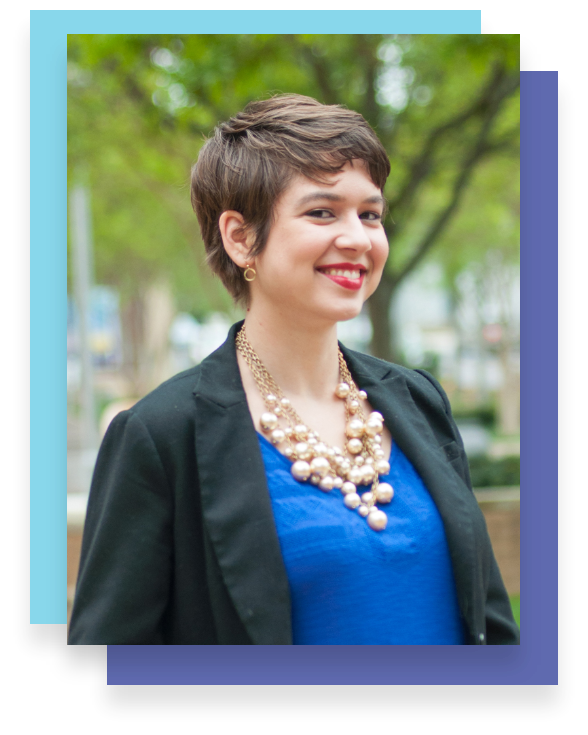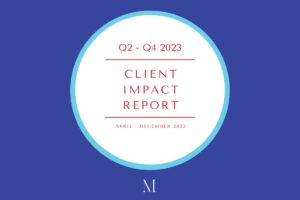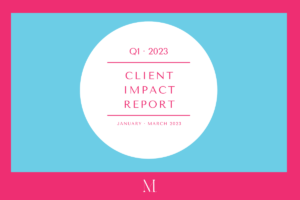It’s dangerous to be a woman thought leader.
At least, it can feel dangerous. Publishing bold, provocative thought leadership invites the whole Internet to disagree with you. Dislike you. Disapprove of you! And this pushback triggers your stress response.
Coping with stress is a CRUCIAL skill for women thought leaders. And there is an undersung and hugely important coping mechanism available to women that we don’t use often enough: intentional microcommunities.
What’s an Intentional Microcommunity?
An microcommunity is an intimate group of peers with whom you can be safely open; who understand and relate to what you are going through; and who validate your experience.
What makes a microcommunity intentional is when it’s created and facilitated with the purpose of being open, supportive, and nurturing.
These communities are a powerful and underused coping mechanism for stress. They help us feel grounded, nourished and protected as we build our authority, push our comfort zones, and create our legacy.
I see an ENORMOUS lack of microcommunities available to women entrepreneurs and thought leaders. The Women Leaders’ Roundtable series I host is my solution to this dearth of microcommunities. I help women thought leaders connect in a special, intentional way.
What Research Says About Microcommunities for Women
Why are these communities so important for women thought leaders? Research shows that community is critical to regulating our stress response — particularly for how women cope with stress.
You’ve probably familiar with the three stress-response F-words — fight, flight, and freeze. You can Google your face off for how to manage the three F’s. Go ahead and do that! It will help you with your whole life.
But that’s not the whole story when it comes to how women cope with stress. Research by Shelley E. Taylor and colleagues shows that women have additional behavioral responses to stress, dubbed tend and befriend: engaging in protective, nurturing activities and relying on social networks that help to nurture and protect.
Tend and Befriend Communities are Hard to Find
Unfortunately, these nurturing and protective networks can be hard to find. Many adult women have a hard time making meaningful connections without the structure of school or hobbies. Furthermore, women entrepreneurs (and many people, post-global-pandemic) have the added challenge of working from home without coworkers.
It can be isolating. Lonely.
Sadly, many of the “solutions” available completely miss the mark of nourishing and protecting. They don’t offer the tend and befriend dynamic women most women desire. Networking events are often loud, crowded, or rushed. Zoom presentations with dozens of participants and a dizzying chat roll do not foster close connection. Some people have great experiences in online communities, but many (like me!) find Facebook/Slack/Mighty Networks groups busy, distracting, and challenging to navigate.
You’d think the Internet and social networks would make this easier, giving us geography-independent access to like-minded people. But the Internet can breed as much isolation, comparison-itis and separation as it can community.
Roundtables: a Microcommunity for Women Thought Leaders
To tend and befriend we must be able to talk safely and comfortably with others. Not shout, not recite our elevator pitch, not type, but talk.
When I think about networking, building community, and making new friends, I want quality, not quantity. I want intimacy and ease, not crowds, rushed agendas, or a pressure to impress.
I had never experienced this kind of microcommunity until I attended a Roundtable hosted by my colleague, Isha. The invitation was to a 90 minute video conversation with a few other entrepreneurs, to share our successes, struggles, and connect with one another.
Ninety minutes? I thought. That’s a lot of time to spend time with people I might not like. But I trust Isha so I took a chance.
It was one of the most intimate, grounding, validating experiences I’ve had professionally.
Our conversation was open and meaningful. I felt deeply connected to the women on the call. The conversation reassured and inspired me, with enough structure that it never felt aimless or long-winded. The questions we took turns answering invited open sharing and intimacy.
I enjoyed it so much I started hosting my own roundtables. After a year of doing them, they are among the most rewarding experiences of my life, personally and professionally.
Something important happens in microcommunities. There is a chemistry that comes alive in a small group that is impossible to facilitate in a larger one.
Why? I’ve discovered three elements that make microcommunities nourishing and protective for women thought leaders. This is what’s missing from 99% of online communities for women and makes microcommunities so powerful:
3 Unique Characteristics of Intentional Microcommunities
1. Gentle Structure
There’s predictability and guidance with structure that makes you comfortable. The facilitator invites you to take turns answering questions, which relieves you of deciding what to say and when to say it.
Whether you’re introverted or extroverted, shy or outgoing, a talker or a listener, the structure ensures that everyone has equal time to speak and be heard. This makes the conversation equitable and relaxing.
It also leaves room for spontaneity! What I love in every Roundtable are the interesting tangents, skill sharing, and brainstorming that arises. Inevitably, every Roundtable conversation takes an unexpected and delightful turn.
2. Intimacy
I’ve never hosted a Roundtable with more than 5 participants (including yours truly). Ninety minutes shared among five people means that no one is rushed. There’s time for everyone to speak and for spontaneous conversations to take off.
The small group format and open-ended questions make the conversation intimate, even though most women have never met before. The questions start broad and become more personal to help everyone feel comfortable.
It doesn’t take more than openness and the right container to facilitate intimacy. We want to connect with each other. As Brené Brown put it, “Connection is why we’re here. It’s what gives purpose and meaning to our lives. This is what it’s all about.”
3. Safety
Gentle structure and intimacy create safety. For tend-and-befriend to work, we must feel safe in each other’s presence to share what we’re going through and rely on each other for support and feedback. The glowing reviews from participants speak to how nourishing and enriching the microcommunity experience is:
- Thank you SO MUCH, Eva! I loved it so much. It was like a balm to my heart. – Angélique
- I’m the first to admit – especially as an INFJ – I don’t *love* any sort of networking. But you created such a safe space where we could all be open, and it led to amazing conversations and insights. – Tracie
- Thank you for creating such an authentic space for women. – Jasmine
- I want to appreciate this space and structure. I feel like I’ve received so much from listening and observing everyone, and observing the way you created this container. – Michelle
- I’ve never had this level of an intimate conversation about my business! I feel positive, energized, very grateful that I met the three of you today. – Suman
- OMGoodness Eva, it was amazing! I really enjoyed your process, your questions, the people you chose. I love making real connections with people and you’ve hit on something wonderful with this format! Thanks so much for including me. – Lena
- That…was…indescribable. THANK YOU! – Jaclyn
Microcommunities are a Powerful Resource for Women Thought Leaders (and they’re more accessible than you think)
Who would have thought that a microcommunity among strangers could have such a powerful effect? It turns out that to get the nourishing and protective benefits of tend-and-befriend, you don’t have to have a tight-knit group of best-girlfriend-fellow-thought-leaders at your fingertips.
While such a microcommunity is indeed meaningful, we can experience deep benefits from one-time conversations with new connections.
How incredible is that!?
By making such experiences part of our routine, we enrich our lives with reassurance and inspiration from our peers. We can regularly manage the stress of being a woman thought leader by making these conversations a priority.
And of course, measurable business impacts come out of growing our networks in an intentional, intimate way: speaking opportunities, email subscribers, client referrals, podcast speaking gigs, and more.
I urge you to seek out and commit to joining intentional microcommunities — or hosting your own. You can start by emailing me to join one of my Roundtables at hello @ medusamediagroup . com. It’s my favorite way to connect with other women thought leaders like you!
Special thanks to Amy Wright for edits. To learn more about my colleague Isha Cogborn’s work, visit her website. Image created by LinkedIn Sales Solutions via Unsplash.





